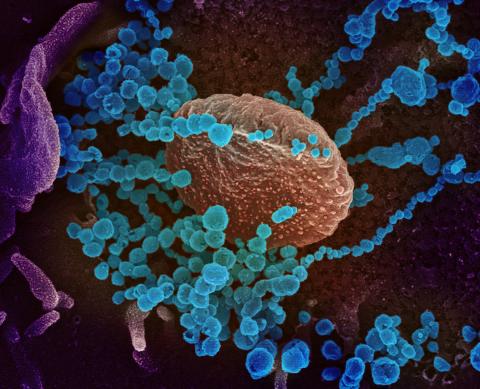Autopsies Add Insight
Pathology Studies Reveal SARS-CoV-2 Present Throughout the Body

The virus that causes Covid-19, SARS-CoV-2, is capable of replicating in multiple tissues across the body, said Dr. Daniel Chertow during a recent Covid-19 scientific interest group lecture.
“SARS-CoV-2 is widely disseminated across the human body and brain early in infection,” said Chertow, a tenure-track investigator in the Clinical Center’s Critical Care Medicine Department and in NIAID’s Laboratory of Immunoregulation.
Between March 2020 and March 2021, his laboratory and colleagues from NCI’s Laboratory of Pathology performed 44 autopsies of patients who had the virus. More than 10,000 tissue samples were taken from all major organs. In addition, brain samples were taken from 11 patients.
Eighty-six percent of patients died from complications of Covid-19; the complication usually was respiratory failure. The rest died with—but not from—Covid-19.
“None of these individuals were vaccinated and all were infected before variants of concern were widely circulating in the United States,” he noted.

Photo: NIAID
On average, the patients autopsied were [59 years old]. They received intensive care in the hospital for long periods of time. About three quarters of them had underlying health conditions associated with higher risk of severe Covid, including cardiovascular disease, chronic respiratory disease, diabetes, hypertension and obesity.
The study is a result of a collaboration with the University of Maryland. Critical care providers from seven Maryland hospitals notified researchers of patients who died with Covid-19. Next of kin gave consent and the remains of the deceased were transferred to the CC.
Chertow’s team and intramural collaborators used several techniques to detect SARS-CoV-2 RNA in tissue samples, including quantitative polymerase chain reaction (PCR), droplet digital PCR technology, in situ hybridization and cell culture.
Together, these methods allowed them to quantify viral levels in tissue samples. Scientists took samples from respiratory, cardiovascular, lymphoid, gastrointestinal, genitourinary, endocrine, skeletal muscle, peripheral and central nervous, and ocular tissue.
“We detected SARS-CoV-2 RNA across all tissue groups, with the highest levels detected in respiratory and cardiovascular tissues,” he said.
During the first week following symptom onset, the virus seeds across the body and infects cells throughout the body, including the brain.
One autopsied patient had a mild case of Covid-19. He later died from liver failure unrelated to his Covid-19 infection. An analysis of tissue samples from his body revealed the presence of viral RNA 8 months after his infection.

Despite the presence of viral RNA in the brain, scientists found no evidence of viral cytopathic effect—structural changes in host cells caused by viral invasion.
More research must be conducted to determine why the virus eludes the immune system in organs besides the lungs for months, Chertow concluded.
To view the virtual presentation, see: https://videocast.nih.gov/watch=45296.
